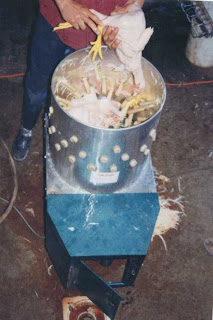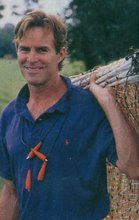 The mobile processing unit being assembled
The mobile processing unit being assembledWe drove 5 hours one way to pay $750 for a used stainless steel plucker that was 4 feet in diameter. We considered ourselves lucky since pluckers were rare as hen’s teeth at that time.
We soon found that four birds spinning in a plucker designed for 12 to 15 just didn’t pick well no matter how we scalded them so we re-rigged our home-made dunker to hold eight birds. (The metal cage to the left of the yellow, half-drum, scald tank held eight birds and, with a single pull of a wire rope, would release them into the plucker.)
That worked better but severely taxed our 30-gallon scald tank with electric heating elements. A bigger problem still was that our lift motor on the dunker was now under powered and needed a human assist on every raise. It was the ten power lifts per batch of birds that broke the camel’s back – in this case I was the camel!
Alice and I were processing 160 birds per day and I was crippled by the end of the second day. We limped over to the Amish butcher shop and helped Ernie Kauffman and his family clean the last of our birds.
 Ernie Kauffman’s original tub plucker
Ernie Kauffman’s original tub plucker
We showed Ernie the video of Joel’s machinery and processing methods and he was mightily impressed. At the time Ernie could pluck a chicken in less than 30 seconds with his ancient table top plucker. After I took Ernie to see some expensive equipment up close, Ernie went right home and built a plucker with a cut down 50-gallon drum, a 2 x 4 frame and a lawn mower engine. This is the photo I submitted to Farm Show magazine in 1995 with the words, "Somebody ought to develop this."
Ernie’s machine spawned a revolution in small scale processing. It inspired the Jako line of equipment, designed by our friend Kenneth King, as well as several simple plan sheets (the first by me) and Herrick Kimball’s Anyone Can Build A Mechanical Tub Style Chicken Plucker in 2002.
 As fate would have it, Alice and I stumbled upon a mini-scale of processing poultry at the Hong Kong farmer’s market.
As fate would have it, Alice and I stumbled upon a mini-scale of processing poultry at the Hong Kong farmer’s market.
(After communal slaughter and scald, vendors at the Hong Kong Farmer’s Market cart their chickens to their stalls to pluck. Five birds are bundled by one foot through slaughter and scald. Note also the crates filled with chickens and the large green feather barrel. These guys sell a lot of chickens every day and there were dozens of venders like this. Transparency in food preparation is normal in countries still strongly connected to the land.)
We saw the same thing in Indonesia where Alice’s parents live, and, with great anxiety, piles of red tape and translation nightmares, we imported a batch of them. We named it the Featherman Jr.
It broke the $1000 price barrier (before Jako you had to spend $3600), picked beautifully, but had two drawbacks – an 18” tub diameter (leaving 12” between fingers) and a belt drive. That meant two chickens at a time, no turkeys and periodic belt adjustments. We knew we could improve on it and save on shipping fees and heart attacks.
 Syl’s plucker, the first Featherman plucker
Syl’s plucker, the first Featherman pluckerThe first, full sized Featherman pluckers – with genuine 50 gallon drums as tubs! – were made by me and another Jamesport Amish neighbor, Syl Graber. They looked like Ernie’s but had metal frames, shrouded 1 horsepower motors, and 10:1 speed reducers. After two years we designed the current plastic model of the Featherman.
Whether you are using a Featherman Junior, one of Syl Graber’s originals or our current Featherman plucker, you owe a debt of gratitude (as do we) to Amish ingenuity, Asian miniaturization, and my - formerly - bad back.









